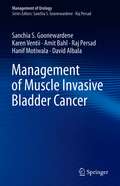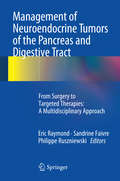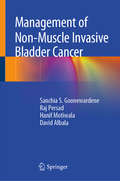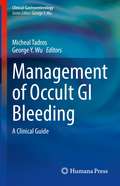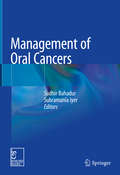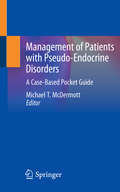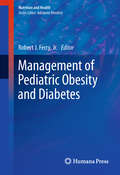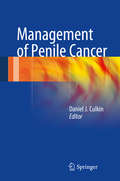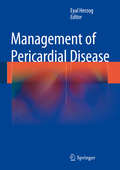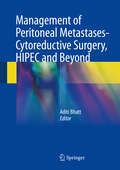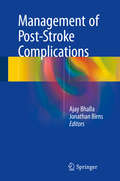- Table View
- List View
Management of Muscle Invasive Bladder Cancer (Management of Urology)
by Hanif Motiwala Raj Persad Sanchia S. Goonewardene David Albala Karen Ventii Amit BahlThis book provides a systematic review of the management and treatment of this disease. The concise and highly structured chapters feature essential background knowledge and commentary on recent advances within each step of a range of patient pathways.Management of Muscle Invasive Bladder Cancer provides a framework for patients’ care based on the research, as well as practically and clinically oriented guidelines. This book is relevant to trainees and practicing urologists and oncologists, in addition to medical professionals involved in the treatment of bladder cancer.
Management of Musculoskeletal Injuries in the Trauma Patient
by Philip F. Stahel Wade R. SmithManagement of Musculoskeletal Injuries in the Trauma Patient summarizes the most current concepts and clinical practices for the management of the patient with musculoskeletal traumatic injuries. The text covers optimal time frames for stabilization of orthopedic injuries and strategies to mitigate systemic injury while minimizing damage due to pelvic, spine and long bone trauma. The volume covers the gamut of traumatic axial and extremity injuries, including cervico-lumbar-thoracic spine injuries, spinal cord injuries, long bone fractures with special emphasis on the femoral shaft, pelvic and acetabular injuries, open fractures, mangled extremities, upper extremity injuries, combination and severe soft tissues injuries and periarticular fractures. These are discussed in the context of isolated injury and combined with orthopedic injuries of the brain, abdomen, chest and other musculoskeletal injuries. Written by internationally recognized experts, Management of Musculoskeletal Injuries in the Trauma Patient is a valuable resource for orthopedic surgeons.
Management of Myocardial Reperfusion Injury
by Juan Carlos Kaski Bernard John Gersh Derek J. Hausenloy Derek M. YellonMuch has been written about reperfusion injury in the past decade but unfortunately the information has been generally presented in the form of original specialist papers and little if any integral publication exists on the topic, summarising and analysing the clinical impact of the condition and its management. The pathophysiology and molecular mechanisms of reperfusion injury are complex and, regarding diagnosis, individual diagnostic techniques have been proposed but without a proper assessment of the relative values of these methods. A publication dealing with integral diagnostic strategies would be welcome by the managing physician. Management of the condition is also problematic, as strategies that appear to work in the experimental models do not translate into beneficial interventions in patients. There is a need for these issues to be addressed and discussed in a monographic fashion. Management of Myocardial Reperfusion Injury will tackle these issues in a modern and systematic way and the information will be delivered in a fashion that will be appealing to the reader.
Management of Neuroendocrine Tumors of the Pancreas and Digestive Tract
by Eric Raymond Sandrine Faivre Philippe RuszniewskiThis book pursues a multidisciplinary approach, presenting chapters with updated information on various aspects of treatment for patients with neuroendocrine tumors. Authors have been selected from expert centers in Europe and the United States. The goal of this book is to comprehensively summarize recent data and provide inspiring ideas to optimize the care of patients with neuroendocrine tumors. Neuroendocrine tumors are fascinating multifaceted diseases that can primarily localize in many organs with various presentations. These tumors are rare but their increasing incidence renders likely that physicians caring for cancers may have either already faced or may be certainly exposed to diagnose and/or treat a patient with neuroendocrine tumors. Over the last years, novel therapeutic options have emerged for neuroendocrine tumors, profoundly challenging practices that had previously been the standards for decades. These include - but are not limited to - somatostatin analogues, targeted therapies such as tyrosine kinase and mTOR inhibitors, antiangiogenic compounds, but also peptide-receptor targeted therapy or radioembolization. This changing field has generated novel treatment algorithms to guide medical decisions. To better understand and handle the multidisciplinary approaches that are required for optimizing the care of neuroendocrine tumor patients, physicians are now looking for references from experts and comprehensive reviews summarizing current knowledge on treatments for patients with neuroendocrine tumors.
Management of Non-Muscle Invasive Bladder Cancer
by Hanif Motiwala Raj Persad Sanchia S. Goonewardene David AlbalaThis book covers the latest advances in non-muscle invasive bladder cancer care. It provides a review of the available evidence base for the efficacy of a range of therapeutic techniques, diagnostic procedures and risk factors. Management of Non-Muscle Invasive Bladder Cancer features detailed guidance in uniformly formatted chapters on how to properly apply a range of available therapeutic treatments relevant for patient care. It is a valuable resource for all trainee and practising medical professionals who treat these patients.
Management of Normal and High-Risk Labour during Childbirth
by Gowri DorairajanThis book deals with the management of labour, guiding the readers to recognize problems by keen monitoring, based on anatomical and physiological understanding of labour. In this era of technology, this book revives the fading art of identification of clinical signs and symptoms. The chapters are well-structured, covering different aspects from suspicion to identification of the problems by recognizing subtle warning signals by the fetus and the uterus. Operative deliveries and common obstetric emergencies with their appropriate management are also covered. It provides practical points to prevent, anticipate, recognize, and manage problems during labour. Key Features Helps to identify clinical signs and symptoms that infuses the reader with confidence to identify and manage abnormal situations during labour and childbirth through the feel of their fingers and awakened understanding. A must have book for all postgraduate trainees and practitioners of obstetrics, eager to learn the fundamentals of labour management. Features illustrated cases helpful in learning management of normal labour and pick abnormal labour, at the earliest possible deviation from normalcy.
Management of Nutritional and Metabolic Complications of Bariatric Surgery
by Aparna Govil Bhasker Nimisha Kantharia Sarfaraz Baig Pallawi Priya Mariam Lakdawala Miloni Shah SanchetiThis book covers the management of various metabolic, nutritional and hormonal complications that arise after bariatric surgery. Until now bariatric surgeons have focused on mastering the surgical technique and reducing surgical complications. A number of metabolic and nutritional complications in the post-surgical phase can remain undiagnosed or unreported with a potential for irreversible morbidity. The book is edited by a team of experienced surgeons and bariatric nutritionists to provide a balanced perspective on the subject. It includes chapters on the prevention and subsequent diagnosis and management of these complications early in the course and explaining each complication with one or more suitable case reports. This book is relevant for practicing as well as aspiring bariatric surgeons, nutritionists/dieticians and bariatric physicians.
Management of Obstructive Sleep Apnea: An Evidence-Based, Multidisciplinary Textbook
by Raman K. Malhotra Ki Beom Kim Reza Movahed Jeffrey J. StanleyThis book provides comprehensive information on the etiology, pathophysiology, medical implications, diagnosis, and surgical and nonsurgical treatment of obstructive sleep apnea (OSA). Divided into five parts, the book begins with principles and fundamentals of OSA and its diagnostic considerations. Subsequent parts then address non-surgical management, surgical management, and maxillomandibular advancements for OSA. Chapters seek to approach this common disorder from the viewpoint of multiple specialties, thereby promoting the development of a broad strategy for the evaluation and management of OSA patients that draws on each of them. An invaluable reference, Management of Obstructive Sleep Apnea: An Evidence-Based, Multidisciplinary Textbook meets the needs of advanced dental and medical students, orthodontic, maxillofacial, ENT, neurology, and plastic surgery residents, and sleep medicine and pulmonary physicians.
Management of Occult GI Bleeding: A Clinical Guide (Clinical Gastroenterology)
by George Y. Wu Micheal TadrosThis book provides a concise, state-of-the-art overview of occult GI bleeding. The text reviews the epidemiology, screening and detection methods for localization, and prominent treatment strategies for occult GI bleeding. It also features a dedicated section on special patient populations including children, premenopausal women, older adults, and patients with other predisposing, and complicating medical conditions. This volume is supplemented with numerous color illustrations, photographs, and table, and is one of the few dedicated resources on occult GI bleeding. Written by experts in the field, Management of Occult GI Bleeding: A Clinical Guide is a valuable resource for clinicians, practitioners, and students who are involved in the treatment of patients with occult GI bleeding.
Management of Open Globe Injuries
by Seanna Grob Carolyn KloekThis book uses a unique case-based approach to review the intra-operative and peri-operative management of patients with severe ocular trauma and open globe injuries. The case- based structure of this text allows readers to easily reference the type of injury they are treating in order to assist with management of their patients and to recognize indications to involve other ophthalmic and surgical specialties in the management of patients with open globe injuries. Management of Open Globe Injuries will be an indispensable resource for ophthalmologists who are called upon to care for patients who have suffered open globe trauma.
Management of Oral Cancers
by Subramania Iyer Sudhir BahadurTumor biology varies at different subsites in the oral cavity, and therefore carcinoma of the gingivo-buccal sulcus (also known as Indian cancer) behaves differently from carcinoma of the tongue. Oral cancer is very often diagnosed at an advanced stage with neck metastasis, and most cases have a guarded prognosis. Loco-regional recurrences are frequent and morbidity following treatment is considerable. However, results have improved in recent years, particularly in early and certain advanced stages, due to better imaging and case selection, improved surgical techniques, including those for reconstructive surgery, a multidisciplinary team approach and a better understanding of tumor biology and prognostic factors.This book comprehensively and systematically reviews all these aspects of diagnostic and therapeutic advances in oral cancer, particularly discussing early detection, epidemiology, chemoprevention and current research. Written by specialists who are active leaders in basic sciences or clinical fields, the chapters address individual and collective issues in managing patients with oral cancer, and provide insights into various treatment approaches. The authors share their knowledge and experience and provide extensive literature sources to encourage clinicians to be flexible, innovative and help them make the best, educated decisions for individual patients.
Management of Orbito-zygomaticomaxillary Fractures
by Hisham Marwan Yoh Sawatari Michael PelegThis excellently illustrated book provides a thorough overview of the management of orbito-zygomaticomaxillary fractures, which can be complex since both function and facial form may be affected. Practical guidance is offered on all aspects, including clinical examination, CT assessment, surgical planning, surgical access and techniques, soft tissue management, intra- and postoperative assessment, and management of complications. In addition, important technological advancements in planning and treatment are described, including the use of navigation systems and 3D printing. Finally, the authors discuss strategies involving delayed surgical intervention and revision surgery for the malpositioned zygomatic maxillary complex. Management of Orbito-zygomaticomaxillary Fractures will be of value for oral and maxillofacial/craniomaxillofacial surgeons at all levels of experience
Management of Pancreatic Cancer and Cholangiocarcinoma
by Hiroyuki Isayama Yousuke Nakai Takashi SasakiThis comprehensive book presents the latest evidence-based data on pancreatobiliary malignancies, including the epidemiology, examination, treatment and endoscopic management. It explores a range of topics, such as risk factors, detection strategies, and novel treatment approaches like precision medicine and immunotherapy.Although there have been rapid improvements in the management of these diseases, the survival period has not yet reached a satisfactory level. This book will help those doctors needing to share the latest information with the patients and their families. It provides a wealth of practical information to help surgeons, endoscopists and oncologists as well as physicians, basic researchers and professionals at medical device and pharmaceutical companies broaden their understanding of the current treatment and management strategies for pancreatobiliary malignancies.
Management of Pancreatic Neuroendocrine Tumors
by Joseph R. PisegnaThis book provides the reader with a multidisciplinary approach that is state of the art and reflects input from the European Neuroendocrine Tumor Society and the North American Neuroendocrine Tumor Society. In particular, the text focuses on the pathophysiology of neuroendocrine tumors and includes a comprehensive review of the most recent developments in understanding the complex hormone and receptor signaling that is important for the future development of potent pharmacological treatments. The volume reviews the pathological grading and staging systems providing useful clinical information for the treating clinician as well as a useful reference for pathologists. The clinical management of neuroendocrine tumors is reviewed enabling the treating physician to understand the diagnostic approaches to differentiating the various types of neuroendocrine tumors. In addition, the treatments are reviewed in great detail and include novel radiological, surgical, and chemotherapeutic approaches. The reader will utilize this book as both a comprehensive and quick reference guide through the use of diagnostic and treatment algorithms. Written by international experts in their particular field of study, Management of Pancreatic Neuroendocrine Tumors will be of great value to medical oncologists, endocrinologists, gastroenterologists, pathologists, surgeons, and diagnostic and interventional radiologists.
Management of Patients with Dementia: The Role of the Physician
by Gunhild Waldemar Kristian Steen FrederiksenThis book provides an overall introduction to the medical management of dementia with chapters dedicated to specific topics such as pain, epilepsy, vascular risk factors in dementia and review of medication, which are often not addressed in books on the subject, and thereby filling a gap in the field. Chapters are supplemented with cases to highlight key concepts and treatment approaches, and to provide the reader with the possibility to reflect on management options and the readers´ own current practice.This book is aimed at clinicians of different specialties (mainly neurology, psychiatry, geriatric medicine and general practice/family medicine) who manage patients with dementia on a regular basis, and thus provides useful guidance to be used in the clinic.
Management of Patients with Pseudo-Endocrine Disorders: A Case-Based Pocket Guide
by Michael T. McDermottComprised of illustrative clinical cases, this unique pocket guide presents descriptions of patients who have symptoms, physical signs or laboratory abnormalities that they believe are due to disorders of the endocrine system (hormone secreting glands and overall metabolism) but which are not, or probably are not, due to an endocrine disorder. These are common situations in the clinical practice of endocrinology. Each chapter includes clinical cases illustrating differing presentations and outcomes, and each individual case description is followed by a discussion that includes the differential diagnosis of these symptoms, signs and/or lab abnormalities and why they are not likely due to endocrine disease or, alternatively, why and how a deeper exploration for endocrine disorders might be needed. In all cases, an emphasis is placed on listening to the patient and providing a respectful and compassionate response and approach to evaluation and management of the proposed disorder. Discussions are referenced whenever reference material is available, and evidence-based clinical practice guidelines are presented whenever applicable. Topics discussed include chronic and adrenal fatigue, obesity, anxiety and depression, sweating and flushing, alcohol- and opioid-induced symptoms, low testosterone, pseudo-hypoglycemia and pseudo-Cushing's syndrome, among others.Clinical endocrinologists, primary care physicians and related allied medical professionals will find Management of Patients with Pseudo-Endocrine Disorders a valuable resource in their clinical practice with these common but often challenging patients.
Management of Pediatric Obesity and Diabetes
by Robert J. Ferry Jr.The twin epidemics of obesity and type 2 diabetes mellitus (T2DM) continue to affect an ever increasing number of children, adolescents, and young adults. Management of Pediatric Obesity and Diabetes provides healthcare trainees and professionals with practical, comprehensive, and contemporary approaches to the pediatric patient at risk for obesity, T2DM, and related conditions. A unique guide on the subject, this volume provides clinical paradigms for diagnosis and management of pediatric T2DM and related conditions, while succinctly describing state-of-the-art basic and clinical sciences underlying these problems. The chapters in this volume are independent and concise. Each chapter focuses on a key clinical issue or mechanism of disease. Providing practical, data-driven resources based upon the totality of the evidence, this important text helps the reader understand the basics of pediatric obesity and T2DM and implement strategies to prevent and treat obesity and diabetes in children and adolescents. Management of Pediatric Obesity and Diabetes provides health professionals across many areas of research and practice with up-to-date, well-referenced, and comprehensive evidence on identification, treatment, and prevention of these chronic, serious, metabolic diseases in children. This volume will serve the reader as the most authoritative resource in the field to date.
Management of Pelvic Organ Prolapse: Current Controversies (Urodynamics, Neurourology And Pelvic Floor Dysfunctions Ser.)
by Vincenzo Li Marzi Maurizio SeratiThis book provides a comprehensive and up-to-date overview of the surgical treatment of pelvic organ prolapse, focusing especially on issues that continue to arouse controversy. In the first section, leading experts present detailed information on the surgical anatomy, pathophysiology, and epidemiology of prolapse and also the impact of concomitant functional disorders. The second section focuses on diagnostic work-up and the third is dedicated to the various treatment options aimed at resolution of the condition. The closing chapters discuss outcome measures and analyze the effects of prolapse surgery on urinary, bowel, and sexual symptoms. In 1966 Richard TeLinde stated that, “Every honest surgeon of extensive and long experience will have to admit that he is not entirely and absolutely satisfied with his long-term results of all his operations for prolapse and allied conditions.” Although many uncertainties in the field have since been resolved, some major issues still require clarification. Often it can be difficult to find the right balance between treatment effectiveness in the long term and risk reduction, including with respect to complications. This book will help trainees and less experienced surgeons to make appropriate treatment choices and achieve optimal outcomes.
Management of Penile Cancer
by Daniel J. CulkinManagement of Penile Cancer provides a comprehensive and state-of-the-art overview of the major issues specific to the field of penile cancer. The sections of the book are structured to review the overall scope of issues of penile cancer, including diagnosis and staging, surgical approaches and the treatment of advanced disease. As multidisciplinary care is an integral part of the treatment of penile cancer, this book is unique in the inclusion of collaborating authors from a variety of integrated disciplines, including urology, radiation oncology, medical oncology and reconstructive surgery. Written by recognized experts in their field, Management of Penile Cancer is a unique and valuable resource in the field of penile cancer, both for those currently in training and for those already in clinical or research practice.
Management of Pericardial Disease
by Eyal HerzogPericardial disease is a broad term that describes a wide range of pathologies. The clinical aspects of pericardial disease encompass acute pericarditis, pericardial tamponade, pericardial effusion, constrictive pericarditis, and effusive-constrictive pericarditis Those disorders differ not only in clinical presentation but also in the timeline of disease development; for example, pericardial tamponade is commonly an acute, life-threatening event, whereas constrictive pericarditis is a chronic process developing over months to years. Therefore, pericardial disease management is challenging for most clinicians. The evidence base in the field is relatively scarce compared with other disease entities in cardiology. European Society of Cardiology released guidelines for the diagnosis and management of pericardial diseases Currently there are no guidelines from American cardiology societies to help clinicians in dealing with pericardial disease. In this book, my goal is to provide extensive review of pericardial disease evaluation and management A unified, stepwise pathway-based approach for the management of pericardial disease is provided at the end of the book.
Management of Peritoneal Metastases- Cytoreductive Surgery, HIPEC and Beyond
by Aditi BhattThe widespread acceptance among the oncology community at large of cytoreductive surgery and HIPEC as a potentially curative treatment for peritoneal metastases has paved the way for innovative new therapies that could benefit a larger proportion of patients. Much has been and continues to be published on this subject.This book provides comprehensive reviews on the various aspects of managing peritoneal metastases. The authors highlight essential practical issues that surgical oncologists encounter in their day-to-day practice, and try to before provide evidence based answers to address them. All chapters were written and/or reviewed by leading experts in this field.
Management of Post-Mortem Pregnancy: Legal and Philosophical Aspects
by Daniel SperlingRecent advances in medical technology have provided healthcare staff with the possibility of maintaining the life of a brain-dead pregnant woman on life-support in order to achieve successful delivery of the foetus. Management of Post-Mortem Pregnancy examines the legal and ethical difficulties surrounding such post-mortem management. Offering practical guidance based on a combined analysis of similar situations that affect pregnant women's lifestyle and physical condition and of the legal framework of pregnancy clauses in advance directive legislation, the volume considers pregnant women's obligations towards their foetuses. It discusses the main moral, legal, psychological, religious, spiritual and physical aspects of the question on the interests of dead people, as well as the jurisprudential question of the foetus' interests. The book will be a valuable guide for all those involved with the decision-making process of such tragic cases. It will also be of wider use to anyone with an interest in legal, ethical and bio-medical issues.
Management of Post-Stroke Complications
by Ajay Bhalla Jonathan BirnsThis book highlights the underlying importance of post-stroke complications during recovery, allowing healthcare professionals managing stroke patients to understand their frequency and identify which patients are at risk of developing such complications. Complications are categorised into neurological and non-neurological, and the time-frame for these complications both in the short-term and long-term are discussed. The common practices in managing post-stroke complications and the skills required in their prevention are described, as is the evidence base from clinical trials around their management. The book concludes with a discussion of new developments and research priorities for the future. Management of Post-Stroke Complications is aimed at members of the multidisciplinary stroke team, stroke physicians, neurologists, general practitioners, stroke specialists in training, and medical students.
Management of Prader-Willi Syndrome
by Phillip D. K. Lee Barbara Y. Whitman Merlin G. ButlerNow in a fully revised and updated fourth edition, this book remains the most comprehensive resource on Prader-Willi syndrome (PWS) available on the market. There have been significant changes in the diagnosis, clinical care and treatment of PWS since the previous edition was published in 2006, and more thorough information on understanding the cause and diagnosis of the condition, along with clinical presentation and findings with natural history data now available. The book is divided into three thematic sections. Part One discusses the genetics, diagnosis, research and overview of PWS, including current laboratory testing. The medical physiology and treatment of PWS comprise Part Two, covering the GI system, obesity as well as the use of growth hormone. Part Three, the largest section, presents a wide-ranging, multidisciplinary management approach to PWS, attending to the many manifestations of the condition. Topics here include neurodevelopmental aspects, speech and language disorders, motor issues, psychological and behavioral management, educational and transitional considerations, vocational training and residential care, and advocacy for both school discipline and sexuality. Syndrome-specific growth charts, benefits eligibility information and additional resources are included in helpful appendices. Timely and well-crafted, this latest edition of Management of Prader-Willi Syndrome remains the gold standard for clinicians and health care providers working with patients diagnosed with this rare obesity-related genetic disorder.
Management of Pregnant and Neonatal Dogs, Cats, and Exotic Pets
by Cheryl LopateManagement of Pregnant and Neonatal Dogs, Cats, and Exotic Pets is a comprehensive yet practical reference on small animal neonatology. Covering reproductive physiology of pregnancy and parturition, normal neonatology, and neonatal disorders in dogs, cats, and small exotic mammals, the book gives special emphasis to fetal well-being, parturition, normal physical parameters, behavior, common disorders and defects, emergency care, and orphan management. Information on nutritional and environmental considerations for both the dam and offspring is included, as well as guidance on offering advice to breeders providing neonatal care at home.Well illustrated throughout, Management of Pregnant and Neonatal Dogs, Cats, and Exotic Pets is a complete resource for the successful management of pregnant and newborn pets. Veterinary practitioners, students, technicians, and professional breeders all will find the book's how-to, clinically relevant approach to small animal neonatology invaluable.
